December 11, 20230001001233false00010012332023-12-112023-12-11
UNITED STATES
SECURITIES AND EXCHANGE COMMISSION
Washington, D.C. 20549
FORM 8-K
CURRENT REPORT
Pursuant to Section 13 or 15(d)
of the Securities Exchange Act of 1934
Date of Report (Date of earliest event reported): December 11, 2023
SANGAMO THERAPEUTICS, INC.
(Exact name of registrant as specified in its charter)
|
|
|
|
|
|
|
|
|
|
|
|
|
|
|
|
|
|
|
|
| Delaware |
|
000-30171 |
|
68-0359556 |
(State or other jurisdiction of
incorporation) |
|
(Commission
File Number) |
|
(IRS Employer
ID Number) |
7000 Marina Blvd., Brisbane, California 94005
(Address of principal executive offices) (Zip Code)
(510) 970-6000
(Registrant’s telephone number, including area code)
Not Applicable
(Former Name or Former Address, if Changed Since Last Report)
Check the appropriate box below if the Form 8-K filing is intended to simultaneously satisfy the filing obligation of the registrant under any of the following provisions:
|
|
|
|
|
|
| ☐ |
Written communications pursuant to Rule 425 under the Securities Act (17 CFR 230.425) |
|
|
|
|
|
|
| ☐ |
Soliciting material pursuant to Rule 14a-12 under the Exchange Act (17 CFR 240.14a-12) |
|
|
|
|
|
|
| ☐ |
Pre-commencement communications pursuant to Rule 14d-2(b) under the Exchange Act (17 CFR 240.14d-2(b)) |
|
|
|
|
|
|
| ☐ |
Pre-commencement communications pursuant to Rule 13e-4(c) under the Exchange Act (17 CFR 240.13e-4(c)) |
Securities registered pursuant to Section 12(b) of the Act:
|
|
|
|
|
|
|
|
|
|
|
|
|
|
|
|
|
|
|
|
| Title of each class |
|
Trading Symbol(s) |
|
Name of each exchange on which registered |
| Common Stock, $0.01 par value per share |
|
SGMO |
|
Nasdaq Global Select Market |
Indicate by check mark whether the registrant is an emerging growth company as defined in Rule 405 of the Securities Act of 1933 (§ 230.405 of this chapter) or Rule 12b-2 of the Securities Exchange Act of 1934 (§ 240.12b-2 of this chapter).
Emerging growth company ☐
If an emerging growth company, indicate by check mark if the registrant has elected not to use the extended transition period for complying with any new or revised financial accounting standards provided pursuant to Section 13(a) of the Exchange Act. ☐
Item 8.01 Other Events.
On December 11, 2023, Sangamo Therapeutics, Inc., or Sangamo, and its collaborator, Pfizer, Inc., or Pfizer, presented updated data from the Phase 1/2 Alta study of giroctocogene fitelparvovec, a gene therapy product candidate for the treatment of moderately severe to severe hemophilia A, at the 65th American Society of Hematology Annual Meeting & Exposition. Giroctocogene fitelparvovec is the subject of the registrational Phase 3 AFFINE clinical trial being conducted by Pfizer. Pfizer expects a pivotal readout in the Phase 3 AFFINE trial evaluating giroctocogene fitelparvovec in the middle of 2024. A copy of the presentation is filed herewith as Exhibit 99.1 and incorporated by reference herein.
Forward-Looking Statements
This Current Report on Form 8-K contains a forward-looking statement regarding Sangamo’s current expectations. This forward-looking statement is the expectation regarding the anticipated pivotal readout in the middle of 2024 for the Phase 3 AFFINE trial. This statement is not a guarantee of future performance and is subject to certain risks and uncertainties that are difficult to predict. Sangamo’s actual results may differ materially and adversely from those expressed in this forward-looking statement. Factors that could cause actual results to differ include, but are not limited to, risks and uncertainties related to: the evolving COVID-19 pandemic and its impact on the global business environment, healthcare systems and the business and operations of Sangamo and Pfizer, including the enrollment of patients in and operation of clinical trials; the research and development process; the uncertain timing and unpredictable nature of clinical trial results, including the risk that therapeutic effects in the Phase 3 AFFINE trial will not be durable in patients; the manufacturing of products and product candidates; the potential for technological developments that obviate technologies used by Sangamo and Pfizer in giroctocogene fitelparvovec; the potential for Pfizer to terminate the giroctocogene fitelparvovec program or to breach or terminate its collaboration agreement with Sangamo; the potential for Sangamo to fail to realize its expected benefits of its collaboration with Pfizer; and other risks and uncertainties described in Sangamo’s filings with the U.S. Securities and Exchange Commission, including its Annual Report on Form 10-K for the year ended December 31, 2022, as supplemented by Sangamo’s Quarterly Report on Form 10-Q for the quarter ended September 30, 2023. The information contained in this Current Report on Form 8-K is as of December 11, 2023, and Sangamo undertakes no duty to update forward-looking statements contained in this Current Report on Form 8-K except as required by applicable laws.
Item 9.01 Financial Statements and Exhibits.
(d) Exhibits.
|
|
|
|
|
|
|
|
|
|
|
|
|
|
|
|
|
|
|
|
Exhibit
No. |
|
Description |
|
|
|
|
|
|
| 99.1 |
|
|
|
|
|
| 104 |
|
|
Cover Page Interactive Data File (embedded within the Inline XBRL document) |
|
|
|
|
|
|
|
SIGNATURES
Pursuant to the requirements of the Securities Exchange Act of 1934, the registrant has duly caused this report to be signed on its behalf by the undersigned hereunto duly authorized.
|
|
|
|
|
|
|
|
|
|
|
|
|
|
|
|
|
|
|
|
|
|
|
|
|
|
|
|
|
|
|
|
SANGAMO THERAPEUTICS, INC. |
|
|
|
|
| Dated: December 13, 2023 |
|
|
|
By: |
|
/s/ SCOTT B. WILLOUGHBY |
|
|
|
|
Name: |
|
Scott B. Willoughby |
|
|
|
|
Title: |
|
Senior Vice President, General Counsel and Corporate Secretary |
EX-99.1
2
ash23hema4-yeardata_fina.htm
EX-99.1
ash23hema4-yeardata_fina
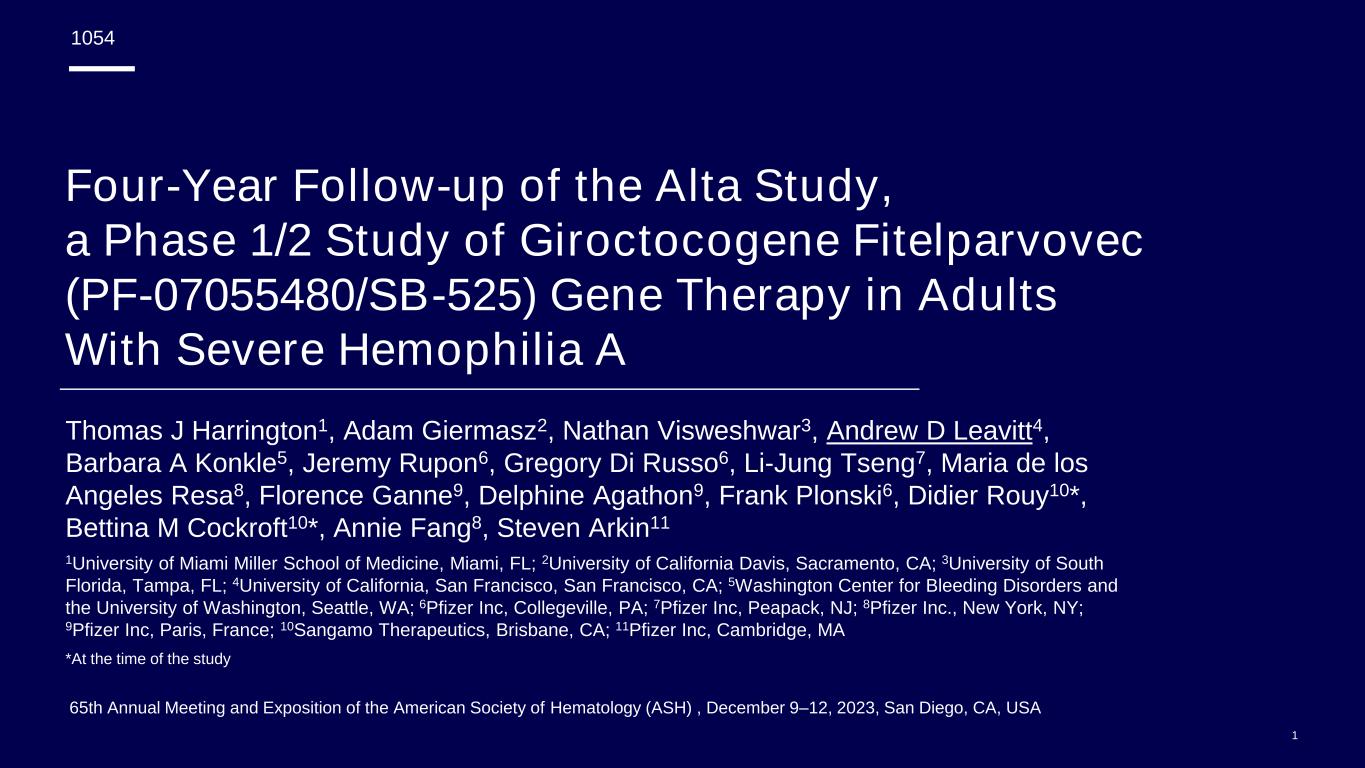
1 65th Annual Meeting and Exposition of the American Society of Hematology (ASH) , December 9–12, 2023, San Diego, CA, USA Four-Year Follow-up of the Alta Study, a Phase 1/2 Study of Giroctocogene Fitelparvovec (PF-07055480/SB-525) Gene Therapy in Adults With Severe Hemophilia A Thomas J Harrington1, Adam Giermasz2, Nathan Visweshwar3, Andrew D Leavitt4, Barbara A Konkle5, Jeremy Rupon6, Gregory Di Russo6, Li-Jung Tseng7, Maria de los Angeles Resa8, Florence Ganne9, Delphine Agathon9, Frank Plonski6, Didier Rouy10*, Bettina M Cockroft10*, Annie Fang8, Steven Arkin11 1University of Miami Miller School of Medicine, Miami, FL; 2University of California Davis, Sacramento, CA; 3University of South Florida, Tampa, FL; 4University of California, San Francisco, San Francisco, CA; 5Washington Center for Bleeding Disorders and the University of Washington, Seattle, WA; 6Pfizer Inc, Collegeville, PA; 7Pfizer Inc, Peapack, NJ; 8Pfizer Inc., New York, NY; 9Pfizer Inc, Paris, France; 10Sangamo Therapeutics, Brisbane, CA; 11Pfizer Inc, Cambridge, MA *At the time of the study 1054

2 • A rare bleeding disorder caused by pathogenic variants in the F8 gene, resulting in insufficient FVIII activity • Current treatment involves replacement therapy with exogenous FVIII or with emerging mimetic-based bispecific antibody therapy, both requiring frequent dosing via IV or SC administration1 • Maintenance of FVIII activity in the mild (>5% to <40%) to normal (>50%) range improves outcomes for patients with severe hemophilia A2 • Hemophilia A has a wide therapeutic window and a single underlying gene defect, making it an ideal candidate for gene therapy3 Hemophilia A FVIII=factor VIII; IV=intravenous; SC=subcutaneous 1. Srivastava A, et al. Haemophilia 2020;26(suppl 6):1-158. 2. White GC, et al. Thromb Haemost 2001;85:560. 3. Leebeek FWG, et al. Blood 2021;138:923-931.
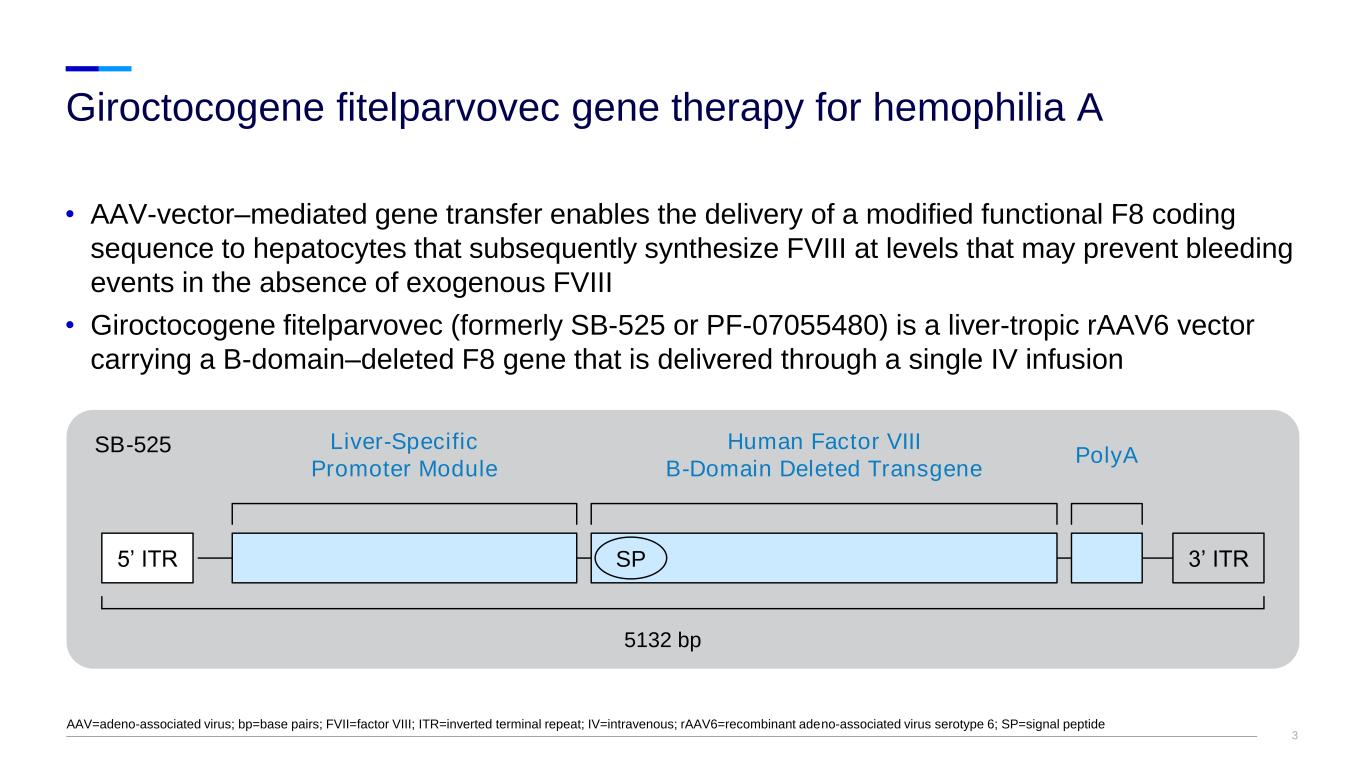
3 • AAV-vector–mediated gene transfer enables the delivery of a modified functional F8 coding sequence to hepatocytes that subsequently synthesize FVIII at levels that may prevent bleeding events in the absence of exogenous FVIII • Giroctocogene fitelparvovec (formerly SB-525 or PF-07055480) is a liver-tropic rAAV6 vector carrying a B-domain–deleted F8 gene that is delivered through a single IV infusion Giroctocogene fitelparvovec gene therapy for hemophilia A AAV=adeno-associated virus; bp=base pairs; FVII=factor VIII; ITR=inverted terminal repeat; IV=intravenous; rAAV6=recombinant adeno-associated virus serotype 6; SP=signal peptide SB-525 Liver-Specific Promoter Module 5’ ITR Human Factor VIII B-Domain Deleted Transgene PolyA 5132 bp 3’ ITRSP

4 • Phase 1/2, single-dose, multicenter, dose-ranging study to assess the safety and tolerability of giroctocogene fitelparvovec in adults (aged ≥18 years) with severe hemophilia A Alta: Study population and design AAV6=adeno-associated virus serotype 6; FVIII=factor VIII Key Exclusion Criteria • Neutralizing activity to AAV6 capsid and/or inhibitor to FVIII • History of hypersensitivity response to FVIII replacement therapy • History of liver dysfunction • Contraindication to steroids Participant Time in Study: 62 months Screening ~8–10 weeks Safety/Efficiency evaluation ~60 months (every 6 months after 1st year) Dose Escalation Cohort Expansion Cohort 1 9e11 vg/kg Cohort 1 2e12 vg/kg Cohort 3 1e13 vg/kg Cohort 4 3e13 vg/kg
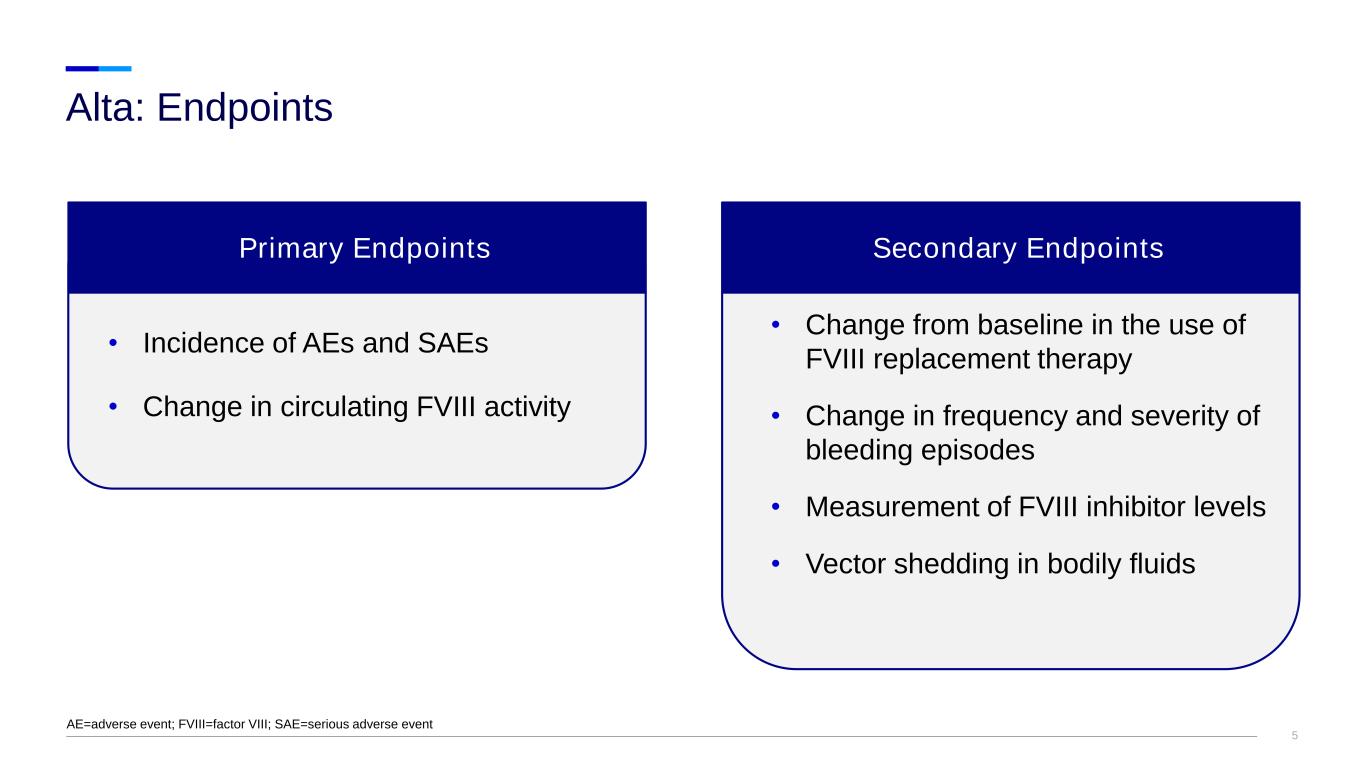
5 Alta: Endpoints AE=adverse event; FVIII=factor VIII; SAE=serious adverse event • Incidence of AEs and SAEs • Change in circulating FVIII activity Primary Endpoints • Change from baseline in the use of FVIII replacement therapy • Change in frequency and severity of bleeding episodes • Measurement of FVIII inhibitor levels • Vector shedding in bodily fluids Secondary Endpoints
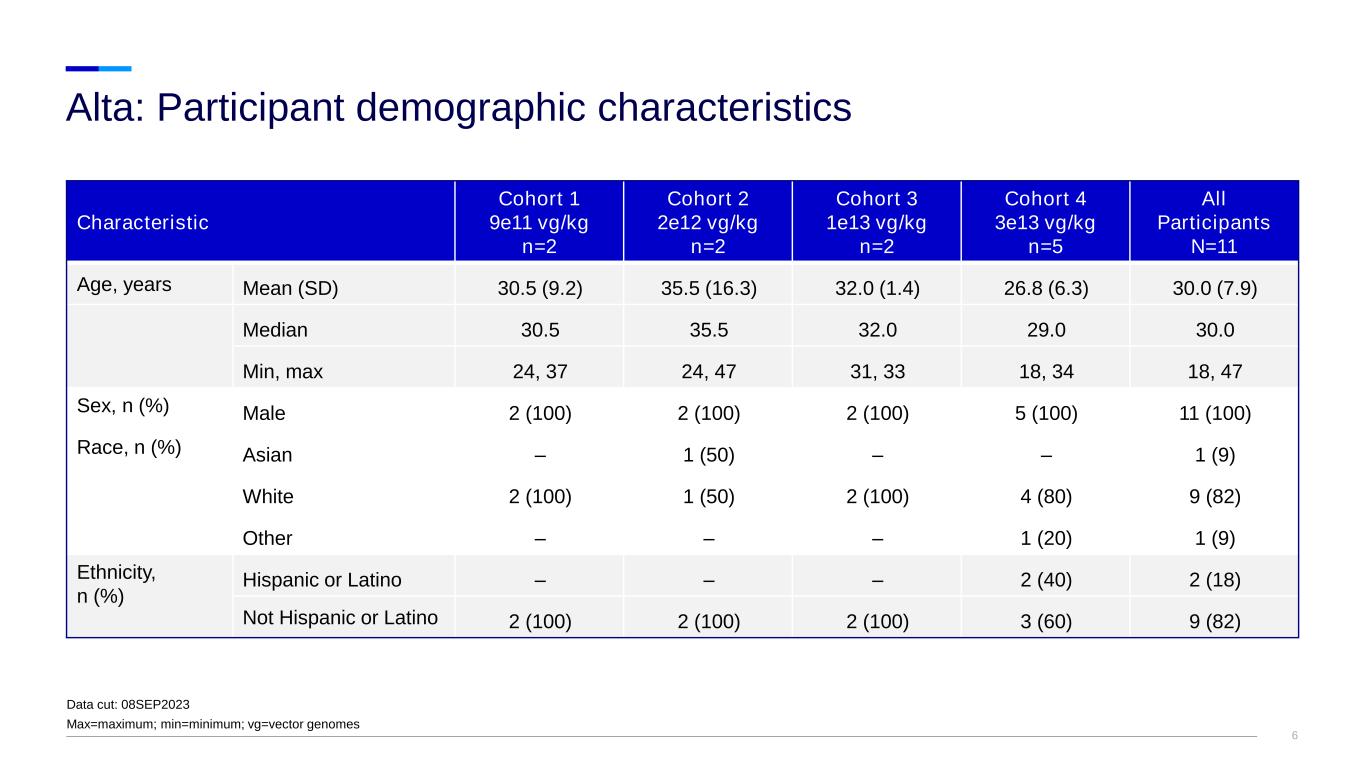
6 Characteristic Cohort 1 9e11 vg/kg n=2 Cohort 2 2e12 vg/kg n=2 Cohort 3 1e13 vg/kg n=2 Cohort 4 3e13 vg/kg n=5 All Participants N=11 Age, years Mean (SD) 30.5 (9.2) 35.5 (16.3) 32.0 (1.4) 26.8 (6.3) 30.0 (7.9) Median 30.5 35.5 32.0 29.0 30.0 Min, max 24, 37 24, 47 31, 33 18, 34 18, 47 Sex, n (%) Male 2 (100) 2 (100) 2 (100) 5 (100) 11 (100) Race, n (%) Asian – 1 (50) – – 1 (9) White 2 (100) 1 (50) 2 (100) 4 (80) 9 (82) Other – – – 1 (20) 1 (9) Ethnicity, n (%) Hispanic or Latino – – – 2 (40) 2 (18) Not Hispanic or Latino 2 (100) 2 (100) 2 (100) 3 (60) 9 (82) Alta: Participant demographic characteristics Data cut: 08SEP2023 Max=maximum; min=minimum; vg=vector genomes
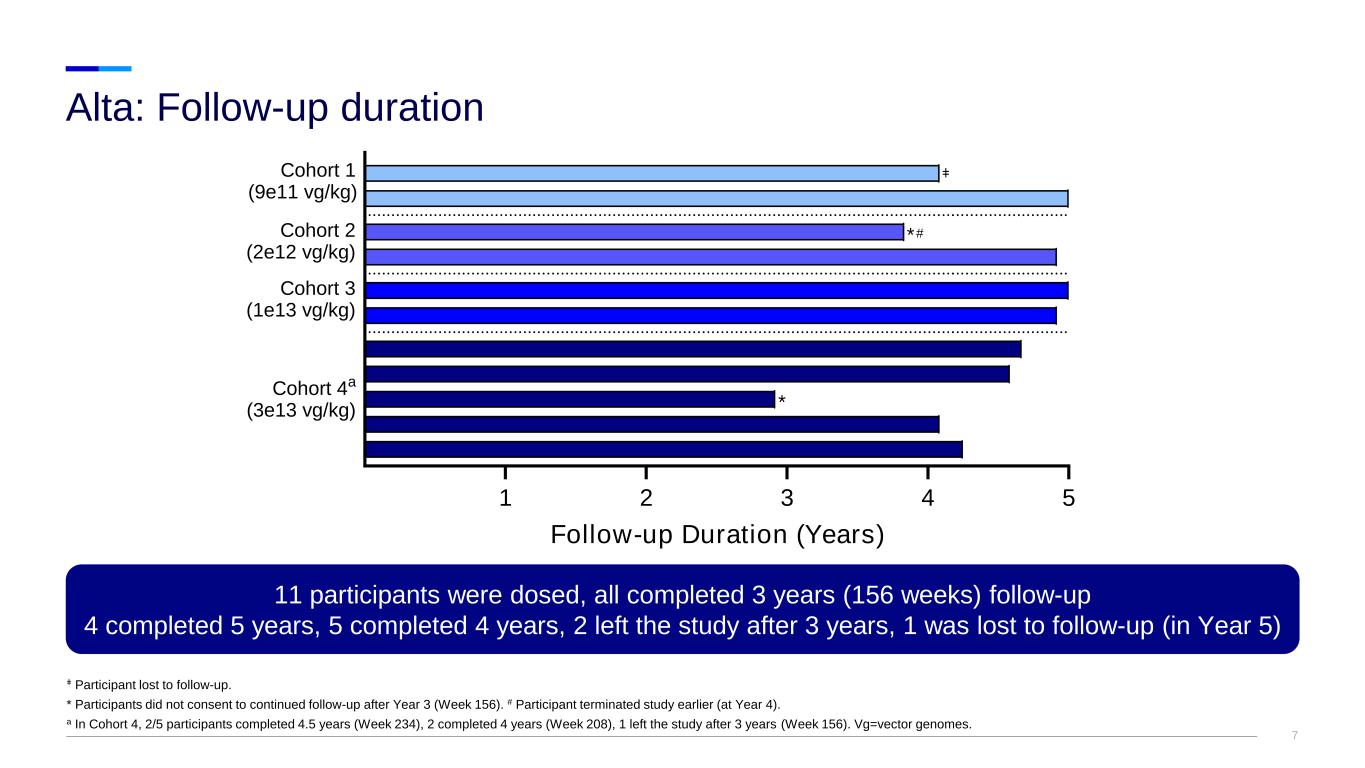
7 11 participants were dosed, all completed 3 years (156 weeks) follow-up 4 completed 5 years, 5 completed 4 years, 2 left the study after 3 years, 1 was lost to follow-up (in Year 5) Alta: Follow-up duration ǂ Participant lost to follow-up. * Participants did not consent to continued follow-up after Year 3 (Week 156). # Participant terminated study earlier (at Year 4). a In Cohort 4, 2/5 participants completed 4.5 years (Week 234), 2 completed 4 years (Week 208), 1 left the study after 3 years (Week 156). Vg=vector genomes. Follow-up Duration (Years) Cohort 1 (9e11 vg/kg) Cohort 2 (2e12 vg/kg) Cohort 3 (1e13 vg/kg) Cohort 4a (3e13 vg/kg) * * # 1 2 3 4 5 ǂ

8 MedDRA Preferred Term Cohort 2 2e12 vg/kg n=2 Cohort 4 3e13 vg/kg n=5 All Participants N=11 n (%) No. of Events n (%) No. of Events n No. of Events Any treatment-related event 2 (100) 5 4 (80) 22 6 (55) 27 Grade 3/4 AE 0 0 1 (20)a 1 1 (9) 1 ALT increasedb 2 (100) 3 3 (60) 10 5 (46) 13 AST increasedb 1 (50) 2 2 (40) 3 3 (27) 5 Pyrexiab 0 0 3 (60) 3 3 (27) 3 Tachycardiab 0 0 2 (40) 2 2 (18) 2 Myalgia 0 0 1 (20) 1 1 (9) 1 Hypotensionb 0 0 1 (20) 1 1 (9) 1 Fatigue 0 0 1 (20) 1 1 (9) 1 FVIII level increasedb 0 0 1 (20) 1 1 (9) 1 • No treatment-related AEs reported for participants in Cohorts 1 and 3 • Infusion-related reactions, occurring within a day of dosing, were reported in 4 of 5 participants in Cohort 4 – Tachycardia (grade 1, n=2), pyrexia (grades 1 and 2, n=3), and hypotension (grade 3, n=1) Alta: Treatment-related adverse events a One participant experienced grade 3 hypotension and grade 2 fever that was an SAE considered related to study drug and resolved with treatment within 24 h. b Denotes AE of special interest. AE=adverse event; ALT=alanine transaminase; AST=aspartate aminotransferase; SAE=serious adverse event; vg=vector genomes

9 • A total of 116 treatment-emergent AEs (all causalities) occurred in 11 participants • 27 treatment-related AEs occurred in 6 participants; the most common were: – ALT increase: 13 events in 5 participants (Cohorts 2 and 4) – AST increase: 5 events in 3 participants (Cohorts 2 and 4) • 4 of 5 participants in Cohort 4 required >7 days of corticosteroid treatment for ALT/AST elevations (by laboratory criteria); all resolved with intervention – LFT elevations were managed with tapering corticosteroids (median: 56 days; range: 7–135 days) – No Cohort 4 participants have required steroids since Week 65; all continue to have ALT values in the normal range (follow-up range: 156–234 weeks) and normal findings via liver MRI (follow-up range: 104–208 weeks) • 1 participant in Cohort 4 experienced treatment-related SAEs of grade 3 hypotension and grade 2 fever ~6 h after completion of the vector infusion, the events fully resolved with treatment • No confirmed FVIII inhibitor development occurred • No thrombotic events, neoplastic events, abnormal AFP, and/or liver masses were reported Alta: Safety summary AE=adverse event; AFP=alfa-fetoprotein; ALT=alanine transaminase; AST=aspartate aminotransferase; FVIII=factor VIII; LFT=liver function test; SAE=serious adverse event
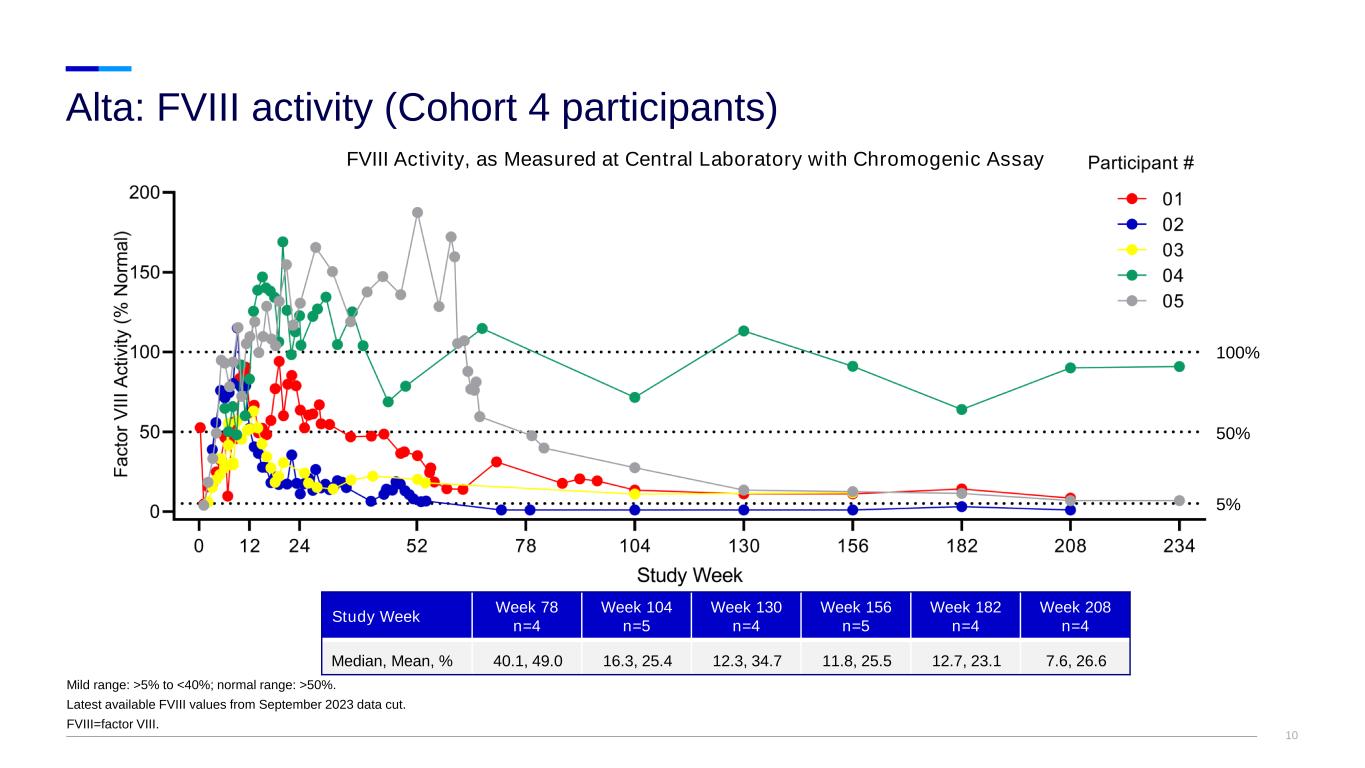
10 Alta: FVIII activity (Cohort 4 participants) Mild range: >5% to <40%; normal range: >50%. Latest available FVIII values from September 2023 data cut. FVIII=factor VIII. FVIII Activity, as Measured at Central Laboratory with Chromogenic Assay 5% 50% 100% Study Week Week 78 n=4 Week 104 n=5 Week 130 n=4 Week 156 n=5 Week 182 n=4 Week 208 n=4 Median, Mean, % 40.1, 49.0 16.3, 25.4 12.3, 34.7 11.8, 25.5 12.7, 23.1 7.6, 26.6

11 Post-infusion: Mean overall ABR = 1.4 Median overall ABR = 0.0 Post-infusion: Mean overall AIR = 5.0 Median overall AIR = 0.4 Alta: ABR and AIR (Cohort 4 participants) ABR calculated as: (number of all bleeding episodes starting 3 weeks after study drug infusion)/(observation period in years). AIR calculated as: (number of FVIII replacement therapy infusions starting 3 weeks after study drug infusion)/(observation period in years). ABR=annualized bleeding rate; AIR=annualized infusion rate. Pre-infusion Post-infusion 0 50 100 150 200 A n n u a li z e d I n fu s io n R a te ( A IR ) mean: 119.3 mean: 5.0 Pre-infusion Post-infusion 0 5 10 15 20 25 A n n u a li z e d B le e d in g R a te ( A B R ) mean: 8.8 mean: 1.4

12 • 0 bleeding events occurred in the first year post infusion • Median and mean (SD) ABR = 0.0 and 1.4 (2.82) for total duration of follow-up (n=5 participants with ≥3 years of follow-up) • 3 of 5 participants (60%) experienced no bleeds • 2 participants experienced bleeding events necessitating treatment with exogenous FVIII; all bleeding events occurred after Week 67 post infusion – 25 treated bleeding events in 1 participant (#02): 11 traumatic, 8 spontaneous, 6 unknown – 1 bleeding event in a target joint in 1 participant (#03): circumstances unknown • Maintenance of FVIII activity (measured with chromogenic assay) – 2 participants with 4.5-year follow-up: mild (6.8%) to normal (90.9%) range – 2 participants with 4-year follow-up: 1 in mild range (8.4%); 1 with FVIII activity BLOQ – 1 participant left study after 3 years follow-up: mild range (11.8%) • No participants in Cohort 4 have resumed prophylaxis Alta: Bleeding events (Cohort 4) ABR calculated as: (number of all bleeding episodes starting 3 weeks after study drug infusion)/(observation period in years). ABR=annualized bleeding rate; BLOQ=below limit of quantification; FVIII=factor VIII

13 • A single infusion of giroctocogene fitelparvovec gene therapy in participants with severe hemophilia A was generally well tolerated, with associated increases in FVIII levels, transient AEs, and mean ABR of 1.4 in the highest-dose cohort (3e13 vg/kg) • Additional follow-up is required to assess durability of efficacy and other long-term effects of giroctocogene fitelparvovec, such as impact on overall liver health • A phase 3 study (NCT04370054) of giroctocogene fitelparvovec in participants with hemophilia A is ongoing and will provide more long-term data on safety and durability Conclusions ABR=annualized bleeding event; AE=adverse event; FVIII=factor VIII; vg=vector genomes
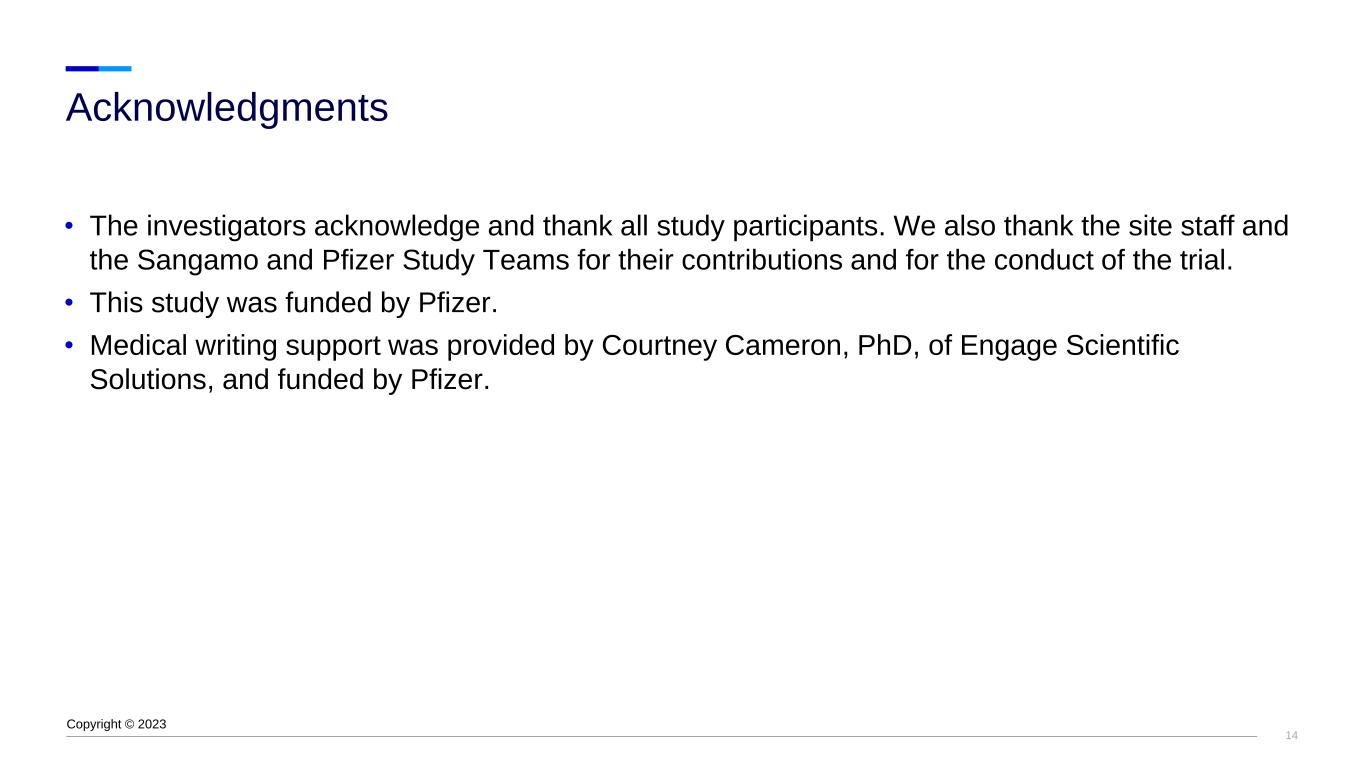
14 • The investigators acknowledge and thank all study participants. We also thank the site staff and the Sangamo and Pfizer Study Teams for their contributions and for the conduct of the trial. • This study was funded by Pfizer. • Medical writing support was provided by Courtney Cameron, PhD, of Engage Scientific Solutions, and funded by Pfizer. Acknowledgments Copyright © 2023













